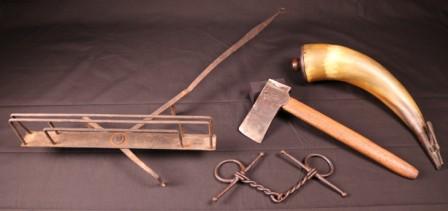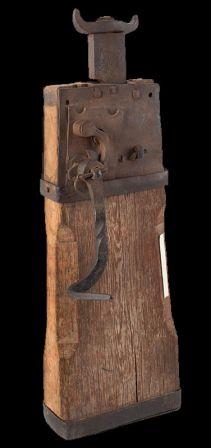C.A.R. Artifact Donation


In celebration of their 125th Anniversary, the Children of the American Revolution (C.A.R.) recently selected several artifacts through the Artifact Donor Program to generously donate to the SAR Museum Collection. The largest object donated by the C.A.R. was a wagon-jack from circa 1780-1790 that remains in working condition. Armies on the march required hundreds of wagons and had to transport artillery on carriages. A jack such as this one was a necessary piece of equipment in the event a wheel, axel, or hub needed to be fixed. It functions much like jacks found in many mechanic’s shops today.
Another artifact donated by the C.A.R. served a daily function familiar to us today, a circa 1760-1790 iron swivel toaster. A long handle allowed the user to comfortably place sliced bread near the fire and when the first side was toasted, rotate 180 degrees. Fresh bread was not made daily, so toasting was common to warm before eating, typically topped with butter or cheese.
The C.A.R. also donated a Revolutionary War era iron horse bit. This bit is of the popular “snaffle” type in use during the era and found in period archeological sites. “Snaffle” bits are jointed in the middle with straight cheekpieces and a central rein loop. With its twisted iron braid design, the blacksmith that made this bit infused decorative elements into an otherwise typically plain piece of equipment.
An American made hatchet from circa 1740-1800 was another C.A.R. donation. This hatchet exhibits several features that are particularly American, including a nearly rectangular profile and raised poll (flattened extension at the back of the head), and similar examples have been discovered in Revolutionary War camp sites. Of typical 18th century blacksmith manufacture, this hatchet clearly shows how it was constructed from a single strap of iron bent around a rod with a smaller chunk of steel inserted for the cutting edge.
The final artifact donated by the C.A.R. is an excellent Revolutionary War era artillery priming powder horn. A spring-loaded brass stopper allowed an artillerist to pour powder in the touch hole that once lit, would then ignite the main powder charge inside the cannon barrel. This horn has a threaded wooden plug in the end that could be removed to quickly refill it. The importance of this horn to its owner is evident by the inscribed folk designs found on its body. The addition of these artifacts donated by the C.A.R. through the Artifact Donor Program will enrich and broaden the SAR Museum Collection. Many thanks to the C.A.R. for their generous gift and happy 125th Anniversary from the SAR!
Article and photos by SAR Curator Zac Distel.
